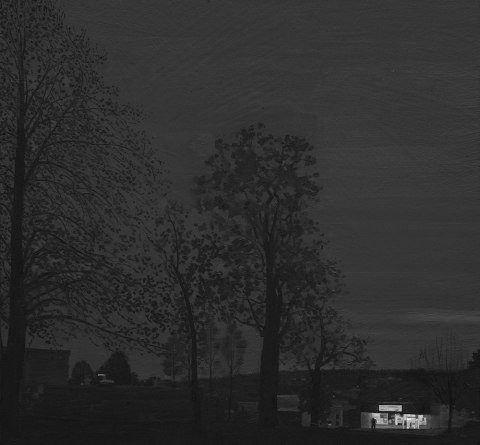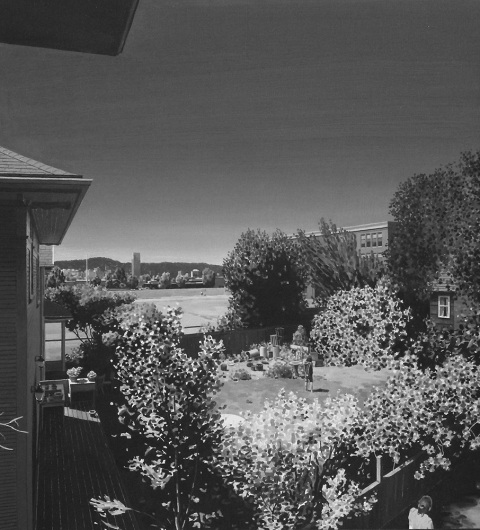A not-for-sale cat. At least 50 shades of gray.
“It can be such an insane, strange undertaking to be an artist.” –Sarah F. Burns
But it can be worth it. To wit, from Sarah F. Burns:
David Rosenak has become sort of a mentor (for me) or an example of having integrity as an artist. So, to set the stage for how he has been an example, I’m going to share where my head is/was. I felt — and still feel — internal pressure to legitimize my obsession with art by turning it into a business. But I’m not capable of “branding” myself with a style and making pieces that are predictable and popular. I absolutely think art is a noble profession and if people sell their work well enough to put food on the table, I think that’s awesome! It’s great when art can be appreciated widely, but if you’re an artist you also know there’s an icky, slippery slope . . . when you’re making art mainly for other people. On the other hand, most of us are not simply expressing ourselves for its own sake, but trying to reach out and connect to some unknown viewer in an authentic and sincere way.
Along with that struggle, there is the battle for technical skills, real ideas and the essential but unpredictable spark of magic that makes good pieces work. It can take years to even come close to making something really special. Years of self-examining, persistent, steady work. To be really great, you have to start young and have some successes; many of those successes are self delusions, but that’s no matter, they keep you going, keep you pushing forward. After all that you still may not have achieved something great, or may not get recognition until you’re gone. It can be such a strange and insane undertaking to “be an artist”.
So here I am, needing to justify all this by making it a business and I meet David. The time when I meet him and first see his work is at a point where he has achieved something special through years of trial and error and persistence. His work is desired by collectors, galleries want to sell his work, and David simply says “No, thank you”. He does not sell his work. I repeat — his paintings are not for sale. He has goals for his work, for sure. He doesn’t create it “for himself” – as the corny line goes. He wants it to be seen in the world by as many people as possible. He knows how long they take to make, how hard he worked to make something he is truly proud of and he wants to cast them in a place where they have the best chance to grow.
And he knows they are precious. They take months and months to complete. He puts scores of hours into each piece. Because time stops for no man, his window for making them is pretty small – as it is for us all – but heightened by the fact that ten years ago David discovered he has Parkinson’s disease, which causes tremors, making painting tiny things a challenge. When he first noticed the tremor it was in his right hand, and after three years he trained himself to paint with his left. (This is so typical of David. Persistent.) Now he can only paint on his good days, still with the left hand.
More interesting things about David: he is color blind. When David was young and testing out his influences, he tried a few paintings in the style of Wayne Thiebauld, but since Thiebaud’s thing has a lot to do with color, David realized he was trying on someone else’s shoes (we all do that when we’re young, but some of us never grow out of it). Then he noticed his primary teacher was making some greyscale paintings, and he realized he’d been fighting a battle with color he had no hope of winning, so he switched to greyscale in 1981 and hasn’t looked back.
David has painted cityscapes since the late 80’s; he showed me a few scenes near his house in a medium sized scale. And they were cool. Then he made them small (nothing larger than 20″ and most average 10″ on the long side) and bam! They suddenly really worked. As the scale was becoming more intimate, the subject moved closer and closer to his home. All the views are of his back yard or his view toward downtown Portland (Oregon). Since he has the subject, scale and approach settled, he is focusing on compositions, and they get more and more mature. He likes to joke that he is essentially making the same painting over and over again in an attempt to improve it. And he has many plans for new paintings within that framework. The adage of freedom coming from limitations is really true, I guess.
Since his subject matter is his yard and what he can see from it, it’s useful to say something about his home. He has a wild, artsy little compound in SE Portland, full of cats and dogs and amazing plants, and all tended to by his neighbor and long time friend, Moe (Maureen). Moe is a gardener and you see in the paintings records of Moe’s work and their friendship. David lives kind of like a cat, moving around his territory, napping, enjoying bits of shade or bits of sun, walking over to his studio a few blocks away to paint, taking the bus across the river to his day job. His paintings are the way a cat would record things because they feel so still, yet so full of life. Like a cat, they contain long moments of stillness while being ready to spring to action at any second. They’re also neutral like a cat. They’re not saying, “Let’s go do this!” or “Think this!” but, “This is fine as it is. I’ll find a comfortable place here.” They say, “I see it all, and it’s fine.”


Oh yay! Thanks for posting this — I just saw it today! Not sure how I missed it.